ترك شاهي
ترك شاهي Türk Şahiler | |||||||||||||||||||
|---|---|---|---|---|---|---|---|---|---|---|---|---|---|---|---|---|---|---|---|
| 665–822 م[1][2] | |||||||||||||||||||
 حاكم ترك شاهي مبكر، ربما برها تگين،[3] مع نقش "سيـِّد راناسريكاري" (الخط البراهمي: | |||||||||||||||||||
| الوضع | امبراطورية بدوية | ||||||||||||||||||
| العاصمة | كابول (العاصمة الصيفية) أوداباندا (العاصمة الشتوية) | ||||||||||||||||||
| اللغات المشتركة | الباكترية | ||||||||||||||||||
| الدين | البوذية، الديانة الإيرانية القديمة، الهندوسية | ||||||||||||||||||
| الحقبة التاريخية | العصور الوسطى المبكرة | ||||||||||||||||||
• تأسست | 665 | ||||||||||||||||||
• انحلت | 822 م[1][2] | ||||||||||||||||||
| |||||||||||||||||||
| اليوم جزء من | أفغانستان پاكستان | ||||||||||||||||||
| حكام الترك شاهي 665-822 م | ||||||||||||||
|---|---|---|---|---|---|---|---|---|---|---|---|---|---|---|
|
||||||||||||||
ترك شاهي (Turk Shahi ؛ تركية: Türk Şahiler) كانوا أسرة حاكمة توركية حكمت من كابول وكاپيسا في القرون السابع إلى التاسع الميلادي. The heartland of their domain was Kabulistan, and at times included Zabulistan[9] and Gandhara. The Turk Shahi replaced the Hunic dynasty of the Nezak. During their rule, they were the bulwark against the eastward expansion of the Abbasid Caliphate. The last Turkic ruler of Kabul, Lagaturman, was deposed by his Brahmin minister in c. 850, signaling the end of the Buddhist Turk Shahi dynasty, and the beginning of the Hindu Shahi dynasty of Kabul.[10]
The Turk Shahis arose at a time when the Sasanian Empire had already been conquered by the Rashidun Caliphate. The Turk Shahis then resisted for more than 250 years to the eastward expansion of the Abbasid Caliphate, until they fell to the Persian Saffarids in the 9th century AD.[11] The Ghaznavids then finally broke through into India after overpowering the declining Hindu Shahis and Gurjaras.[1][12]
Kabulistan was the heartland of the Turk Shahi domain, which at times included Zabulistan and Gandhara.[9]
Territorial extents
The Turks under the Western Turk ruler Tong Yabghu Qaghan crossed the Hindu-Kush and occupied Gandhara as far as the Indus river from circa 625 AD.[13][14] Overall, the territory of the Turk Shahi extended from Kapisi to Gandhara, with a Turkic branch becoming independent in Zabulistan at one point.[15][16][17] The Gandhara territory may have been bordering the Kashmir kingdom and the Kanauj kingdom to the east.[15] The Turk Shahi capital of Gandhara, which possibly fonctionned as a winter capital alternating with the summer capital of Kabul, was Udabhandapura.[18] The Korean pilgrim Hui Chao, visiting the area in 723-729 AD, mentioned that these regions were ruled by Turk kings.
التاريخ
التأسيس: الهجوم العربي ونزوح هون النزاك
From around 625 AD, the Turks progressively displaced the Hunnish tribe of the Nezak first in Zabulistan (area of Ghazni) and then in Kabulistan (area of Kabul) and in Gandhara as far as the Indus river.[13][14] The Chinese pilgrim Xuanzang, visiting Kapisi in 629 AD, testified that "... the Turks have lived in the mountain area between Zabulistan and Kapisi".[19] Visiting the area a century later in 723–729, the Korean Buddhist pilgrim Hyecho would attest the areas of Gandhara, Kapisa and Zabulistan to be under Turk rule (突厥 Tūjué, "Turks").[14]
The last extant Nezak ruler was Ghar-ilchi who was formally installed as king of Jibin (former Kapisi/ Kabulistan) by the Tang Dynasty in 653 AD, and again as Governor of Jibin under the newly formed Protectorate General to Pacify the West, in 661 AD.[7][20] The Turk Shahis must have risen some time soon, probably simultaneously to the successful Arab invasion and capture of Kabul under Abd al-Rahman ibn Samura of the Rashidun Caliphate c. 665 AD, on the heels of their decade-long effort to expand into Turkic areas.[21][أ]
Al-Biruni in his Tārīkh al-Hind ("History of India") notes their founder to be one Barhatakin (Barha Tegin) and provides a rather-legendary account of his rise to power:[24]
The Hindus had kings residing in Kabul, Turks who were said to be of Tibetan origin. The first of them, Barhatakin, came into the country and entered a cave in Kabul, which none could enter except by creeping on hands and knees. [...] Some days after he had entered the cave, he began to creep out of it in the presence of the people, who looked on him as a newborn baby. He wore Turkish dress, a short tunic open in front, a high hat, boots and arms. Now people honoured him as a being of miraculous origin, who had been destined to be king, and in fact he brought those countries under his sway and ruled them under the title of a Shahiya of Kabul. The rule remained among his descendants for generations, the number of which is said to be about sixty. [...] The last king of this race was Lagatarman, and his Vizir was Kallar, a Brahman.
According to the 726 CE account of the Korean monk Hyecho who visited the region, Barha Tegin was a former ally of Ghar-ilchi, who went on to usurp the throne:[25][20]
From Kashmir I travelled further nortwest. After one month's journey across the mountains I arrived at the country of Gandhara. The king and military personnel are all Turks. The natives are Hu people; there are Brahmins. The country was formerly under the influence of the king of Kapisa. A-yeh [alternatively "The father"][ب] of the Turkish King took a defeated cavalry [alternatively "led an army and a tribe" or "led troops of his entire tribe"][ت] and allied himself to the king of Kapisa. Later, when the Turkish force was strong, the prince assassinated the king of Kapisa [possibly Ghar-ilchi] and declared himself king. Thereafter, the territory from this country to the north was all ruled by the Turkish king, who also resided in the country.
محمية تانگ والخضوع ليابغو تخارا
The Turk Shahis, like the rest of the Western Turks, were nominally part of a protectorate under the Chinese Tang Dynasty since circa 658 AD.[29] The territory of the Turk Shahis was nominally partitioned into several Chinese Commanderies under administration of the Anxi Protectorate: the city of Yege (modern Mihtarlam) east of Kabul was considered as the seat of a Chinese Commandery for the Jibin country, and named the Xiuxian Commandery (修鮮都督府, Xiūxiān Dūdùfû),[30] the city of Yan at the border with Gandhara was the seat of the Yuepan Commandery (悅般都督府, Yuèpān Dūdùfû), Ghazni was the seat of the Tiaozhi Commandery (條枝都督府, Tiáozhī Dūdùfû).[31][32]
According to Chinese sources, in particular the chronicles of the Cefu Yuangui, the Turks in Kabul were vassals of the Yabghus of Tokharistan, who in turn swore allegiance to the Tangs.[33] A young brother of the Tokhara Yabghu Pantu Nili—named Puluo (僕羅 púluó in Chinese sources)—visited the court of the Tang Dynasty in Xi'an in 718 AD and gave an account of the military forces in the Tokharistan region, explaining that "two hundred and twelve kingdoms, governors and prefects" had been recognizing the authority of the Yabghus (specifically mentioning among them that "the king of Zabul rules two hundred thousand soldiers and horses, the king of Kabul two hundred thousand"), since the time of his grandfather, that is, probably since the time of their establishment.[33][34][ث][ج]
النزاع مع العرب
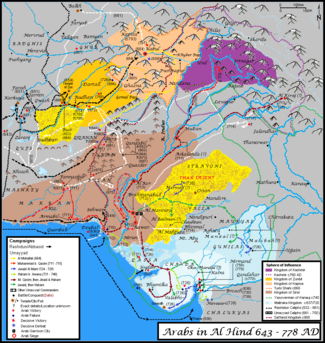
Under Barha Tegin, the Shahis mounted a counter-offensive and repulsed the Arab forces after Abd al-Rahman ibn Samura was replaced as Governor of Sistan c.665 CE, taking back lost territory as far as the region of Arachosia and Kandahar.[36][37][38] The capital was shifted from Kapisa to Kabul.[21] The Arabs attempted a counter-offensive when Rabi ibn Ziyad al-Harithi assumed the governorship of Sistan in 671 CE, attacking the Turkic "Rutbil" at Bost, and driving him to al-Rukhkhaj (Arachosia).[36] Rabi's successor Ubayd Allah ibn Abi Bakra continued the war upon being appointed in 673 CE, leading Rutbil to negotiate a peace treaty for both Kabul and Zabul, in which the governor of Sistan acknowledged control of these territories by Rutbil and the King of Kabul.[36] Little more is known about the rule of Barha Tegin, but many of the early Turk Shahi coins are attributed to him.[39]
He was succeeded by his son Tegin Shah c. 680, whose regal title was "Khorasan Tegin Shah" meaning "Tegin, King of the East", probably referring to his resistance against the Umayyad caliph.[38][40] His territory comprised the area from Kabulistan to Gandhara and initially included Zabulistan, which came to be ruled by Rutbil (Turkic: Iltäbär), his elder brother, who founded the dynasty of the Zunbils.[40] Their relationship was at times antagonistic, but they fought together against Arab incursions.[40][41]
The Arabs again failed to capture Kabul and Zabulistan in 683 AD: their general Abu Ubaida ibn Ziyad was imprisoned in Kabul and Governor of Sijistan Yazid ibn Ziyad was killed as he attacked the city.[12][42] In 684–685, Kabul briefly comes under Arab control.[42] In 698 Ubayd Allah ibn Abi Bakra of the Umayyad Caliphate lead an 'Army of Destruction' against the Zunbils, was defeated and was forced to offer a large tribute, give hostages including three of his sons and take an oath not to invade Zunbil again.[43] About 700 Ibn al-Ash'ath tried again to invade with the 'Peacock Army', but after some initial progress eventually formed a peace treaty with the Turks, and turned around to lead a rebellion against the Umayyad viceroy of the east, al-Hajjaj ibn Yusuf.[44]
Tegin Shah apparently regained complete suzerainty over Zabulistan around 710 CE.[40] This appears from the accounts in the Chinese chronicles, which relates that the rulers of Zabulistan "subjugated themselves to Jibin (Kabul)", sometime between 710 and 720 CE.[45] During this period, it seems the Zunbils and the Turk Shahis intermittently accepted, or were forced to accept, payment of taxes to the Arabs, thereby acknowledging some form of political dependence, but resisted fiercely when the Arabs attempted to take a more direct military, political or religious control.[46]
From 711 CE, the Turk Shahis also had to face a Muslim threat from the southeast, as the campaigns of Muhammad ibn Qasim established the Caliphal province of Sind, as far as Multan, at the gates of Punjab, which would last until 854 CE as an Ummayad and then Abbasid dependency.[47]
Tang Dynasty investiture
In 719/20 CE, the Tegin of Kabulistan (Tegin Shah) and the Iltäbär of Zabulistan (here named "Shiquer") sent a combined embassy to Xuanzong, the Chinese Emperor of the Tang Dynasty in Xi'an, to obtain confirmation of their thrones.[30] The Chinese emperor signed an investiture decree, which was returned to the Turk rulers. The official Chinese recognition of the enthronement of Tegin Shah appears in the annals of the Tangshu:
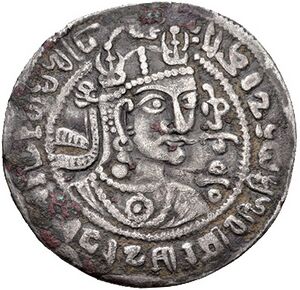
In the seventh year of the Kaiyuan reign [719 CE], [Jibin (Kabul) dispatched] envoys to the [Tang] court, who offered up a book of an astrological text, secret medical recipes, together with foreign medecines and other things. An imperial edict was issued to bestow on the king [of Jibin] the title Geluodazhi Tele [for "Tegin"].
The word "Geluodazhi" in this extract (Chinese: 葛罗达支, pronounced in Early Middle Chinese: kat-la-dat-tcǐe), is thought to be a transliteration of the ethnonym Khalaj.[50] Hence Tegin Shah was described as "Tegin of the Khalaj".[50] This title also appears on his coinage in Gupta script, where he is named "hitivira kharalāča", probably meaning "Iltäbär of the Khalaj".[50]
In 720 CE, the ruler of Zabulistan (謝䫻, Xiėyù) also received the title Gedaluozhi Xielifa (Chinese: 葛達羅支頡利發), Xielifa being the known Chinese transcription of the Turkish "Iltäbär", hence "Iltäbär of the Khalaj".[51] This appears in another extract from the Tangshu describing the country of Zabulistan (谢䫻, Xiėyù), mentioning how Zabulistan was a vassal to the Kabul Shah around the same period, and how the Zunbil ruler, named "Shiquer", was also recognized by the Chinese court:[52][53]
The people from Tujue (Turks), Jibin (Kabul), and Tuhuoluo (Tokharistan) live together in this country [Zabulistan]. Jibin recruits from among them young men to defend against Dashi (Arabs). They sent an envoy to the Tang in the first year of Jingyun (710) to present gifts. Later, they subjugated themselves to Jibin. In the eighth year of Kaiyuan (720), the Emperor approved the enthronement of Gedalouzhi ("Khalaj") Xielifa ("Iltäbär") Shiquer. Their envoys came to the royal court several times until the Tianbao era (742–756).
— Old Book of Tang, Book 221: account of Zabulistan (谢䫻 Xiėyù).[54]
These two Chinese accounts tend to confirm that the Turk Shahi and Zunbil rulers were Khalaj Turks.[55] The Korean pilgrim Hyecho accompanied the return embassy in 726 AD, and wrote an account of his travel and visit at the court of Kabul, relating that Turk ("T’u-chüeh") kings ruled the territories of Gandhara, Kapisa and Zabulistan at the time, that they were Buddhists, and that the King of Kabul was the uncle of the ruler of Zabul.[56][40]
الانتصار على العرب
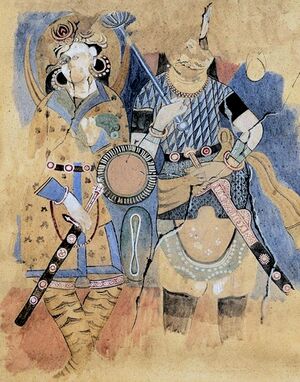
In 739 CE, Tegin abdicated in favour of his son Fromo Kesaro:[37][ح]
In the 27th year [of Kaiyuan, ie 739 CE], the king Wusan Tela Sa [for Khorasan Tegin Shah] submitted a memorial requesting that due to his old age, his son Fulin Jisuo may succeed him on the throne. The emperor agreed and dispatched an envoy in order to confer the king's title on him through an imperial edict.
"Fromo Kesaro" is probable phonetic transcription of "Rome Caesar".[12][61] He was apparently named in honor of "Caesar", the title of the then East Roman Emperor Leo III the Isaurian who had defeated their common enemy the Arabs during the Siege of Constantinople in 717 AD, and sent an embassy to China through Central Asia in 719 AD which probably met with the Turk Shahis.[12][خ] In Chinese sources "Fromo Kesaro" was aptly transcribed "Fulin Jisuo" (拂菻罽娑), "Fulin" (拂菻) being the standard Tang Dynasty name for "Byzantine Empire" and Jisuo (罽娑) the phonetic transcription of "Caesar":[20][62][61][63]
Fromo Kesaro appears to have successfully fought against the Arabs.[12][64] His coinage suggests that the Arabs were defeated and forced to pay tribute to Fromo Kesaro, since Sasanian coins and coins of Arab governors were overstruck by him on the rim with the following text in the Bactrian script:[65]
الوجه: ϕρoµo κησαρo βαγo χoαδηo κιδo βo ταzικανo χoργo
الظهر: oδo σαo βo σαβαγo ατo ι µo βo γαινδo
Fromo Kesaro, the Majestic Sovereign, [is] who defeated the Arabs and laid a tax [on them]. Thus they sent it.
Since these coins did not come out from Fromo Kesaro's foundries, but were simply pre-existing Arab/Sasanian coins which he overstruck on the rim with his victorious legends in Bactrian, it would seem that in all likelihood the coins underwent this rather simple overstriking procedure in the field, probably during one of his victorious campaigns against the Muslims.[64]
Fromo Kesaro's victories may have forged parts of the epic legend of the Tibetan King whose name appears to be phonetically similar: Phrom Ge-sar.[12][65]
فض محمية تانگ
قالب:South Asia in 800 CE In 745 AD, Fromo Kesaro's son Bo Fuzhun (勃匐準 Bo Fuzhun in Chinese sources) became the king, as recorded in the Old Book of Tang;[ر] he was simultaneously conferred with the Tang title "General of the Left", which probably alludes to a strategic relationship between the Chinese and the Turk Shahis, in the context of expanding Islamic frontiers.[47]
The Chinese departed from the region c. 760 AD, following their strategic defeat at the Battle of Talas (751 AD) and the events of the An Lushan Rebellion, thus weakening the geopolitical position of the Turk Shahis.[71] Al-Yakubhi records that c. 775–785, a Turk Shahi ruler of Kabul—variously reconstructed as Ḥanḥal/Khinkhil/Khingil/Khingal—was sent a proposal by Al-Mahdi (775-785), the third Abbasid Caliph, asking for his submission, to which he conceded.[ز][74] He was either a unique ruler of the Turk Shahis or identical with Bo Fuzhun.[74][75][76][77][78]
تجدد النزاع مع العرب والانحدار
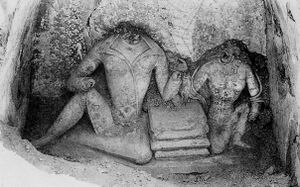
The struggle between the Arabs and the Turk Shahis continued into the 9th century AD.[12] Hoping to take advantage of the Great Abbasid Civil War (811-819 AD), the Turk Shahi, named "Pati Dumi" in Arab sources, invaded parts of Khorasan.[20] Once the Abbasid caliph Al-Ma'mun prevailed in the Civil War, he sent troops to confront the Turk invaders: in 814/815 AD, the Turk Shahis were soundly defeated by these Arab troops, which pushed as far as Gandhara.[82][2] The Turk Shah now had to convert to Islam, and had to pay an annual tribute of 1,500,000 dirhams and 2,000 slaves to the Abbasid governor of Khorasan.[82][2] He also ceded a large and precious idol made of gold, silver and jewels, which was sent to Mecca.[20] Following Al-Azraqi's initial account of 834 AD, Quṭb ed-Dîn wrote:
Now, when this King converted to Islam, he decided that the throne with the idol should be given as an offering for the Ka'ba. He therefore sent the throne to Al-Ma'mun in Merv, who then sent it to Al-Hasan ibn Sahl in Wasit, who in turn charged one of his lieutenants from Balkh, Naçîr ben Ibrahim, with accompanying it to Mecca. This lieutenant arrived there in the year AH 201 (816 AD) during the time of pilgrimage when Isḥâḳ ben Mûsá ben ´Isá was leading the pilgrims to the holy sites. When they returned from Mina, Naçîr ben Ibrahim placed the throne with the carpet and the idol in the center of the square dedicated to Omar Ibn Al-Khattab, between Safa and Marwa, where it remained for three days.
— Quṭb ed-Dîn, History of the city of Mecca[83]
Al-Azraqi also made a very detailed description of the statue, which points to a crowned and bejewelled Buddha seated on a throne, a design otherwise well known and quite specific to this historical period for the region of Afghanistan and Kashmir.[84] In the south, the Zunbil Turk Shahis escaped unaffected and continued to rule for about two more decades, before falling in 870/871 AD to the Saffarids under an upstart adventurer Ya'qub ibn al-Layth al-Saffar.[85]
Takeover by the Hindu Shahis (822 CE)
According to the Arab chronicler al-Biruni, the last Turk Shahi ruler of Kabul, Lagaturman—probable son of Pati Dumi—was deposed by a Brahmin minister, named Kallar around 822 AD.[20][86] A new dynasty, the Hindu Shahi took over, with its capital in Kabul.[2] To the south, the Zunbils held fort against Muslim forces until the Saffarid offensive of 870 CE.
Society and Religion
The Alchon Huns, predecessors of the Turk Shahis in Afghanistan and Gandhara, had brought destruction upon Buddhism.[88] When Chinese pilgrim Xuanzang visited northwestern India in ح. 630 AD, he reported that Buddhism had drastically declined, and that most of the monasteries were deserted and left in ruins.[89] The Turk Shahis are reported as having been supporters of Buddhism, and are generally presented as Buddhists.[87][90] There was a renewed patronage of Buddhism in the area of Afghanistan during the 7-8th century AD as a function of the expansion of the Tang Dynasty power in Central Asia at that time, just as the Arabs were pressuring Khorasan and Sistan.[91] The Korean pilgrim Hui Chao in 726 AD recorded in the Chinese language that the Turkic (突厥, Tū-chuèh) rulers of Kapisa ("Jibin") followed the Triratna and dedicated many Buddhist temples:[87]
(...) 至罽賓國。(...) 此國土人是胡。王及兵馬突厥。(...) 國人大敬信三寶。足寺足僧。百姓家各絲造寺。供養三寶。大城中有一寺。名沙糸寺。寺中貝佛螺髻骨舍利見在王官百姓每日供養。此國行小乘。
(...) I arrived in Jibin.(...) The natives of the country are Hu (Barbarian) people; the king and the cavalry are Turks (突厥, Tūjué). (...) The people of this country greatly revere the Three Jewels. There are many monasteries and monks. The common people compete in constructing monasteries and supporting the Three Jewels. In the big city there is a monastery called Sha-hsi-ssu. At present, the curly hair (ushnisha, 螺髻) and the relic bones of the Buddha are to be seen in the monastery. The king, the officials, and the common people daily worship these relics. Hinayana (小乘) Buddhism is practised in this country.
The Kingdoms of Central Asia, often Buddhist or with an important Buddhist community, were generally under the formal control of the Tang Dynasty, had regular exchanges with China, and expected Tang protection.[91] Chinese monks were probably directly in charge of some of the Buddhist sanctuaries of Central Asia, such as the temple of Suiye (near Tokmak in present-day Kirghizistan).[91] During this period too, the Chinese Tang Empire extended its influence and promotion of Buddhism to the kingdoms of Central Asia, including Afghanistan, with a corresponding influx of Chinese monks, while there was conversely a migration of Indian monks and artistic styles from India to Central Asia, as "Brahmanical revivalism" was pushing Indian Buddhist monks out of their country.[95][91]
According to the Chinese pilgrim Wukong, who arrived in Gandhara in 753 AD,[87] the country of Kapisi had its eastern capital in Gandhara during the winter, and its capital in Kapisi during the summer.[87] In Kashmir, which he visited from 756 to 760 AD, he explained that Buddhist temples were dedicated by the Tü-kiu ("Turk") kings.[87] Brahmanism too seems to have flourished, but to a lesser extent, under the Turk Shahis, with various works of art also attributed to their period.[87][96]
At the end of the 10th century, the Samanid Empire led by the Turk ghulams Alp Tigin established itself in Eastern Afghanistan, later followed by the Ghaznavid dynasty.[97][98] At that time, local Buddhist Turk communities seem to have mingled with the newly arrived Muslim Turks of the Samanid Empire, forming an ethnic continuity among the ruling class of Ghazni. The local Buddhist Turks progressively islamized, but there was a continuation in artistic development and Buddhist religious activities, not a break.[98] The Buddhist site of Qol-i Tut in Kabul remained in use until the end of the 11th century.[98]
العملات

From the middle of the 7th century AD, the Turk Shahis emulated the coinage of their predecessors, the Hunnish Nezak-Alchons.[1][80] The first coins of the Turk Shahi kept the winged bull's head of the Nezak as well as their legend "King of Nezak" (nycky MLKA) but in corrupted Pahlavi script. But the style of the rulers in the coins was now quite different, and the coins were of markedly higher silver quality.[21] Soon, these coins introduced a new legend in replacement of the "King of Nezaks" legend, using the Indian honorific "Shri" ("Perfection") with the royal title "Shahi" in the Bactrian language (σριο Þανιο, Srio šauoi) and in Sanskrit (Śri Sāhi).[99][80] This new coinage corresponds to the formal establishment of the Turk Shahis, sometime after 661 AD.[1][80]
In later stages, the crown adorned with a bull's head is replaced by a crown consisting in three crescent moons in the middle of which a flower or trident is set.[80][س] Often the bull's head in the crown is also replaced by the symbol of a lion's or a wolf's head.[103][104] In other coins the triple-crescent moons were kept, and the king was shown wearing a Central Asian caftan.[7]
Many of these coins are attributed to Shahi Tegin, the second Turk Shahi ruler, and dated to circa 700 AD.[105] After this transitory period, Turk Shahi coinage adopted the Sasanian coinage style, and added a trilingual legend in Greco-Bactrian, Pahlavi, and Brahmi. Based on finds, Turk Shahi coins apparently circulated in Zabulistan, Kabulistan, Gandhara and Uddiyana.[1]
Crowns with the head of a lion or a wolf[104] as central symbol, on the obverses of two Turk Shahi coins. This new symbol replaced the earlier bull's head of Nezak Huns coinage.[103]
A Turk Shahis ruler named Sandan, otherwise unknown. Copy of a late issue of Khusrau II, combining Brahmi script around the ruler, Bactrian script along the two rims, where "ςανδανο βαγο χοαδηο" "Lord King Sandan" is mentioned, and Pahlavi around the altar on the reverse.[107][108]
الفن
There was a relatively high level of artistic activity in the areas controlled by the Turk Shahis during 7-8th centuries AD, either as a result of the Sasanian cultural heritage, or as a result of the continued development of Buddhist art, with possible Hephthalite influence.[101] The destruction upon Buddhism wrought by their predecessors had deeply weakened the Hellenitic-Buddhist art of Gandhara.[88] Yet, consequent to Tang patronage of Buddhism, a Sinicized-Indian phase re-developed during the 7th to 9th century AD.[95] The Western Turks in Afghanistan are generally associated with a major revival of Gandharan Buddhist art between the 7th and 9th century AD, especially in the areas of Bamiyan, Kabul and Ghazni, with major new Buddhist sites such as Tapa Sardar in Ghazni, or Tepe Narenj and Mes Aynak near Kabul, which remained active at least until the 9th century AD.[98] This process and chronology are visible in the archaeological site of Tapa Sardar near Ghazni in Afghanistan, while this new form of art appears in its mature state in Fondukistan.[109]
أعمال الفن البوذي
The works of art of this period in eastern Afghanistan, with a sophistication and iconography comparable to other works of art of the Silk Road such as those of Kizil, are attributable to the sponsorship of the "cosmopolitan" Turks, rather than their "Ephthalite" predecessors in this area (the Nezak-Alchon Huns), who, in the words of Edmund Bosworth, "were not capable of such work".[59] And, soon after, the expansion of Islam made the creation of such works of art impossible.[59]
The style as well as the techniques used in making these works of art (modelling of clay mixed with straw, wool or horsehair), are characteristic of the paintings and sculptures of Central Asia.[110] The production of Fondukistan must correspond to the southernmost expansion of this particular type of Buddhist art.[110] The new region occupied by the Turk Shahis had numerous Buddhist monasteries, such as Mes Aynak, which appear to have remained in use until the 9th century AD.[7] Dedications including Turk Shahis coins have been found under a statue in the Buddhist monastery of Fondukistan.[1][111]
Devotees or sponsors wearing Central Asian clothes such as the tight-fitting double-lapel caftan appear in the Buddhist Monastery of Fondukistan, as in the statue of a King wearing the caftan and pointed boots, seated together with a Queen of Indian type, and dated to the 7th century AD.[112][80]
Dedications including coins of the Buddhist Turk Shahis and one Sasanian coin of Khusro II have been found under the statue of the royal couple with a king in Turk attire in the monastery of Fondukistan, providing important insights regarding the datation of the statue as well as Buddhist art in general: as a result of the analysis the statue can be dated to after 689 AD, and as a consequence a date of circa 700 AD is generally given for it and the other works of art of Fondukistan.[57][1][111] The royal couple consists in a princess in "Indian" dress, and a prince "wearing a rich caftan with double lapel and boots", characteristic of Central Asian clothing.[113][114]
Mural of a Bodhisattva Maitreya at the entrance of the niche of the royal couple. Fondukistan monastery, circa 700 AD. National Museum of Afghanistan.
The period of the Turk Shahis also corresponds to the last stages of Greco-Buddhist art. circa 700 AD, Fondukistan monastery, Ghorband District, Afghanistan
Seated Buddha, Fondukistan monastery. National Museum of Afghanistan.[115]
Seated Maitreya, 7th-8th century AD, near Kabul, Afghanistan. "Stylistically related to Shahi sculpture of northern Pakistan and Afghanistan".[116]
أعمال الفن البراهماني
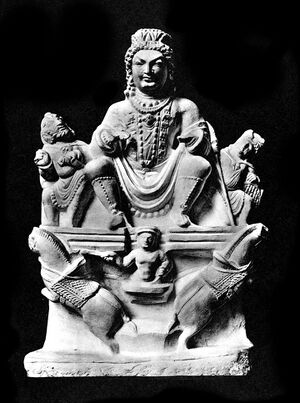
Brahmanism too seems to have flourished to some extent under the Turk Shahis, with various works of art also attributed to their period.[121][122] In particular the famous statue of a Sun deity that is either Mitra or Surya in tunic and boots discovered in Khair Khaneh near Kabul,[118] as well as a statue of Ganesha from Gardez are now attributed to the Turk Shahis in the 7-8th century AD, and not to their successors the Hindu Shahus as formerly suggested.[121] In particular, great iconographical and stylistic similarities with the works of the Buddhist monastery of Fondukistan have been identified.[121] Archaeologically, the construction of the Khair Khaneh temple itself is now dated to 608-630 AD, at the beginning of the Turk Shahis period.[123]
The marble statue of Ganesha from Gardez is now attributed to the Turk Shahis,[121] and was donated by a certain "Śrī Ṣāhi Khiṃgāla", possibly the Turk Shahi king named "Khingala" who according to Al-Yakubhi gave his submission to Al-Mahdi in 775-785.[124][125][126]
Seated Avalokiteshvara, white marble, Khair Khaneh, 6th-7th century CE. Musée Guimet MA 8151.[127]
Khair Khaneh donor, wearing a tunic, boots and a sword.
The Gardez Ganesha is now dated to the 8th century and attributed to the Turk Shahis.[121]
See also
| تاريخ الشعوب التوركية قبل القرن 14 | |
|---|---|
| الخاقانية التوركية 552–744 | |
| التوركية الغربية | |
| التوركية الشرقية | |
| خاقانية الآڤار 564–804 | |
| خاقانية الخزر 618–1048 | |
| شوىيانتوو 628–646 | |
| بلغاريا الكبرى 632–668 | |
| بلغاريا الدانوب | |
| بلغاريا الڤولگا | |
| اتحاد قنغر 659–750 | |
| خاقانية تورگش 699–766 | |
| خاقانية الويغور 744–840 | |
| دولة قارلوق يابگو 756–940 | |
| خانية القرةخانات 840–1212 | |
| القرة خانات الغربيون | |
| القرة خانات الشرقيون | |
| مملكة ويغور گانسو 848–1036 | |
| مملكة قوچو 856–1335 | |
| خانيات الپچنگ 860–1091 |
خانية كيمك 743–1035 |
| القومان 1067–1239 |
دولة غز يابگو 750–1055 |
| أسر شاتوو 923–979 | |
| تانگ اللاحقة | |
| جين اللاحقة | |
| هان اللاحقة (هان الشمالية) | |
| السلطنة الغزنوية 963–1186 | |
| السلاجقة العظام 1037–1194 | |
| سلاجقة الروم | |
| سلطنة خوارزم 1077–1231 | |
| سلطنة دلهي 1206–1526 | |
| الأسرة المملوكية | |
| الأسرة الخلجية | |
| أسرة تغلق | |
| القبيل الذهبي | [128][129][130] 1240s–1502 | |
| السلطنة المملوكية (القاهرة) 1250–1517 | |
| المماليك البحرية | |
Notes
- ^ In 653-4 AD, an army of around 6,000 Arabs led by general Samura had seized Rukhkhaj and Zamindawar. In the shrine of Zoon in Zamindawar, Samura "broke off a hand of the idol and plucked out the rubies which were its eyes in order to persuade the marzbān of Sīstān of the god's worthlessness."[22] Samura explained to the marzbān: "my intention was to show you that this idol can do neither any harm nor good."[23] Bost and Zabul submitted to the Arab invader by treaty in 656 CE.[22] The Muslims soon lost these territories during the First Civil War (656-661).[22]
- ^ According to Shōshin Kuwayama, "A-yeh" (阿耶) is not a personal name but means "father"; refers to Barha Tegin, father of then-King Tegin Shah (680-739 CE).[26]
- ^ The original Chinese segment is "領一部落兵馬", which Kuwayama translates in Japanese: "軍と一部落とを領有し" "He led an army and a tribe"; Fuchs translates "mit den Truppen seines ganzen Stammes" "with the troops of his entire tribe".[26]
- ^ This account also shows that the Yabghu of Tokharistan ruled a vast area circa 718 AD, formed of the territories north and south of the Hindu Kush, including the areas of Kabul and Zabul.[35]
- ^ "On the Dingwei day of the eleventh month in the sixth year of the Kaiyuan era, Ashi Tegin Puluo (阿史特勒僕羅) writes to the emperor: Tokhara Yabghu (吐火羅葉䕶), his elder brother, is controlling as his subordinates two hundred and twelve persons, such as the local kings of various states, Dudu (Governors-General), and Cishi (heads of regional governments). The king of Zabul rules two hundred thousand soldiers and horses, the king of Kabul two hundred thousand, each king of Khuttal, Chaghanian, Jiesu (解蘓國), Shughnan, Evdal (悒達國), Kumedha Wa'khan (䕶宻國), Guzganan, Bamiyan, Lieyuedejian (久越徳建國), and Badakhshan fifty thousand." Cefu Yuangui 3.5. Fanyan in Vol. 999 (Claims, Foreign Subjects), 718 AD. in Kuwayama, Shoshin (2005). "Chinese Records on Bamiyan: Translation and Commentary". East and West. 55 (1/4): 143–144. ISSN 0012-8376. JSTOR 29757642.
 هذا المقال يضم نصاً من هذا المصدر، الذي هو مشاع. Original text of Cefu Yuangui 3.5. Fanyan in Vol. 999: 六年十一月丁未阿史特勒僕羅上書訴曰僕羅克吐火羅葉䕶部下管諸國王都督刺史總二百一十二人謝颺國王統領兵馬二十萬衆罽賔國王統領兵馬二十萬衆骨吐國王石汗那國王解蘓國王石匿國王悒達國王䕶宻國王䕶時健國王范延國王久越徳建國王勃特山王各領五萬衆僕羅祖父已来並是上件諸國之王蕃望尊重僕羅兄般都泥利承嫡繼襲先𫎇恩勑差使持節就本國册立為王然火羅葉䕶積代以來扵大唐忠赤朝貢不絶本國緣接近大食吐蕃東界又是西鎮僕羅兄每徴發部落下兵馬討論擊諸賊與漢軍相知聲援應接在扵邊境所以免有侵漁僕羅兄前後屢𫎇聖澤媿荷國恩遂發遣僕羅入朝侍衛玉階至願獻忠殉命以為臣妾僕羅至此為不解漢法鴻臚寺不委蕃望大小有不比類流例髙下相懸即奏擬授官竊見石國龜兹并余小國王子首領等入朝元無功効並緣蕃望授三品将軍况僕羅身恃勤本蕃位望與親王一種北䫫大小與諸國王子懸殊却授僕羅四品中郎但在蕃王子弟娑羅門瞿曇金剛龜兹王子白孝順等皆數改轉位至諸衛將軍唯僕羅最是大蕃去神龍元年𫎇恩勑授左領軍衛翊府中郎將至今經一十四年久被淪屈不𫎇准例授職不勝苦屈之甚勑鴻臚卿准例定品秩勿令稱屈 in "冊府元龜 (四庫全書本)/卷0999 - 维基文库,自由的图书馆". zh.m.wikisource.org.
هذا المقال يضم نصاً من هذا المصدر، الذي هو مشاع. Original text of Cefu Yuangui 3.5. Fanyan in Vol. 999: 六年十一月丁未阿史特勒僕羅上書訴曰僕羅克吐火羅葉䕶部下管諸國王都督刺史總二百一十二人謝颺國王統領兵馬二十萬衆罽賔國王統領兵馬二十萬衆骨吐國王石汗那國王解蘓國王石匿國王悒達國王䕶宻國王䕶時健國王范延國王久越徳建國王勃特山王各領五萬衆僕羅祖父已来並是上件諸國之王蕃望尊重僕羅兄般都泥利承嫡繼襲先𫎇恩勑差使持節就本國册立為王然火羅葉䕶積代以來扵大唐忠赤朝貢不絶本國緣接近大食吐蕃東界又是西鎮僕羅兄每徴發部落下兵馬討論擊諸賊與漢軍相知聲援應接在扵邊境所以免有侵漁僕羅兄前後屢𫎇聖澤媿荷國恩遂發遣僕羅入朝侍衛玉階至願獻忠殉命以為臣妾僕羅至此為不解漢法鴻臚寺不委蕃望大小有不比類流例髙下相懸即奏擬授官竊見石國龜兹并余小國王子首領等入朝元無功効並緣蕃望授三品将軍况僕羅身恃勤本蕃位望與親王一種北䫫大小與諸國王子懸殊却授僕羅四品中郎但在蕃王子弟娑羅門瞿曇金剛龜兹王子白孝順等皆數改轉位至諸衛將軍唯僕羅最是大蕃去神龍元年𫎇恩勑授左領軍衛翊府中郎將至今經一十四年久被淪屈不𫎇准例授職不勝苦屈之甚勑鴻臚卿准例定品秩勿令稱屈 in "冊府元龜 (四庫全書本)/卷0999 - 维基文库,自由的图书馆". zh.m.wikisource.org.
- ^ Martin 2011, p. 127:"He received this laudatory epithet because he, like the Byzantines, was successful at holding back the Muslim conquerors."
- ^ Martin 2011, p. 127:"He received this laudatory epithet because he, like the Byzantines, was successful at holding back the Muslim conquerors."
- ^ The study of these new coins originally appeared in "New Coins of Fromo Kēsaro" by Helmut Humbach in: G. Pollet (ed.), "India and the Ancient World. History, trade and culture before A.D. 650". Professor P.H.L. Eggermont jubilee volume. Leuven 1987, 81-85, plates. XI-XIII
- ^ Tianbao (天寶, 742–756), era name used by Emperor Xuanzong of Tang
- ^
天寶四年,又冊其子勃匐準為襲罽賓及烏萇國王,仍授左驍衛將軍
In the 4th year of the Tianbao reign [745 CE][ذ] another imperial edict was issued to make his [i.e. Fromo Kesaro's] son Bo Fuzun succeed him on the throne as the King of Jibin and Uddiyana. He was conferred the title of "General of Left Stalwart Guard". - ^
Al-Mahdī sent messengers to the kings, calling on them to submit, and most of them submitted to him. Among them were the king of Kābul Shāh, whose name was Ḥanḥal; the king of Ṭabaristān, the Iṣbahbadh; the king of Soghdia, the Ikhshīd; the king of Tukhāristān, Sharwin; the king of Bamiyan, the Shīr; the king of Farghana, ------ ; the king of Usrūshana, Afshīn; the king of the Kharlukhiyya, Jabghūya; the king of Sijistān, Zunbīl; the king of Turks, Tarkhan; the king of Tibet, Ḥ-h-w-r-n; the king of Sind, al-Rāy; the king of China, Baghbür; the king of India and Atrāḥ, Wahūfūr; and the king of the Tughuz-ghuz, Khāqān.
- ^ In nearby Kakrak, a valley next to Bamiyan, a famous Buddhist mural named "The Hunter King" (7-8th centuries AD) shows a typically local royal figure seated on a throne, his bow and arrows on the side. He wears a triple-crescent crown which is said to have a close similarity to the triple-crescent crowns on the coinage found in northeastern Afghanistan in the area of Zabulistan, for example this coin from Ghazni.[100][40] Other authors have attributed the triple-crescent crown to Hephthalite influence.[101] The painting may be an allegory of a King abandoning violence, particularly the hunting of animals, and converting to Buddhism.[102]
المراجع
- ^ أ ب ت ث ج ح خ "Contained within a clay urn were a gold bracteate with the portrait of a ruler, three early drachms of the Turk-Shahis (Type 236, one of which is countermarked), and a countermarked drachm of the Sasanian king Khusro II dating from year 37 of his reign (= 626/7). The two countermarks on Khusro 's drachm prove that the urn could only have been deposited after 689" Alram 2014, pp. 282–285
- ^ أ ب ت ث Alram, Michael; Filigenzi, Anna; Kinberger, Michaela; Nell, Daniel; Pfisterer, Matthias; Vondrovec, Klaus. "The Countenance of the other (The Coins of the Huns and Western Turks in Central Asia and India) 2012-2013 exhibit: 16. The Hindu Shahis in Kabulistan and Gandhara and the Arab Conquest". Pro.geo.univie.ac.at. Kunsthistorisches Museum Vienna. Retrieved July 22, 2017.
- ^ Kuwayama 1993, Coin E.254.
- ^ Kuwayama 1993, For a clear example of the wolf, see [1]. Also:
 .
.
- ^ Millward, James A. (2007). Eurasian Crossroads: A History of Xinjiang (in الإنجليزية). Columbia University Press. p. 31. ISBN 978-0-231-13924-3.
- ^ Göbl 1967, 254 ; Vondrovec type 254
- ^ أ ب ت ث ج Alram, Michael; Filigenzi, Anna; Kinberger, Michaela; Nell, Daniel; Pfisterer, Matthias; Vondrovec, Klaus. "The Countenance of the other (The Coins of the Huns and Western Turks in Central Asia and India) 2012-2013 exhibit: 13. The Turk Shahis in Kabulistan". Pro.geo.univie.ac.at. Kunsthistorisches Museum Vienna. Retrieved July 16, 2017.
- ^ See coin 3 from the same ruler in Alram, Michael; Filigenzi, Anna; Kinberger, Michaela; Nell, Daniel; Pfisterer, Matthias; Vondrovec, Klaus. "The Countenance of the other (The Coins of the Huns and Western Turks in Central Asia and India) 2012-2013 exhibit: 14. Kabulistan and Bactria at the Time of "Khorasan Tegin Shah"". Pro.geo.univie.ac.at. Kunsthistorisches Museum Vienna. Retrieved July 16, 2017.
- ^ أ ب "15. The Rutbils of Zabulistan and the "Emperor of Rome"". Pro.geo.univie.ac.at. Retrieved July 22, 2017. خطأ استشهاد: وسم
<ref>غير صالح؛ الاسم "Turk Shahi" معرف أكثر من مرة بمحتويات مختلفة. - ^ "16. The Hindu Shahis in Kabulistan and Gandhara and the Arab conquest". Pro.geo.univie.ac.at. Retrieved July 22, 2017.
- ^ Alram, Michael (1 February 2021). Sasanian Iran in the Context of Late Antiquity: The Bahari Lecture Series at the University of Oxford (in الإنجليزية). BRILL. p. 21. ISBN 978-90-04-46066-9.
- ^ أ ب ت ث ج ح خ خطأ استشهاد: وسم
<ref>غير صحيح؛ لا نص تم توفيره للمراجع المسماةHJK58 - ^ أ ب Klaus Vondrovec (2014). Coinage of the Iranian Huns and Their Successors from Bactria to Gandhara (4th to 8th Century CE). ISBN 978-3-7001-7695-4.
- ^ أ ب ت Laet, Sigfried J. de; Herrmann, Joachim (January 1996). History of Humanity: From the seventh century B.C. to the seventh century A.D. (in الإنجليزية). UNESCO. p. 475. ISBN 978-92-3-102812-0.
- ^ أ ب خطأ استشهاد: وسم
<ref>غير صحيح؛ لا نص تم توفيره للمراجع المسماةMI443 - ^ Dani, Ahmad Hasan; Litvinsky, B. A. (January 1996). History of Civilizations of Central Asia: The crossroads of civilizations, A.D. 250 to 750 (in الإنجليزية). UNESCO. p. 375. ISBN 978-92-3-103211-0.
- ^ خطأ استشهاد: وسم
<ref>غير صحيح؛ لا نص تم توفيره للمراجع المسماةacademia.edu - ^ "The capital of the state of Kapisa–Gandhara (possibly, its winter capital) was Udabhandapura, now the settlement of Hund, situated on the right bank of the Kabul river. Most of the city was surrounded by a defensive rampart." in Harmatta, J.; Litvinsky, B. A. (1992). History of Civilizations of Central Asia: Tokharistan and Gandhara under Western Türk Rule (650-750) (in الإنجليزية). Unesco. p. 391. ISBN 978-92-3-103211-0.
- ^ Vondrovec, Klaus. "Coinage of the Nezak" (in الإنجليزية): 173.
{{cite journal}}: Cite journal requires|journal=(help) - ^ أ ب ت ث ج ح Rahman, Abdur; Bopearachchi (Ed.), Osmund; Boussac (Ed.), Marie-Françoise (2002). Afghanistan. Ancien Carrefour entre l'Est et l'Ouest (New Light on Khingal, Turk and Hindu Shahis). Vol. XV. Turnhout, Belgium: Brepols. pp. 37–41. ISBN 2-503-51681-5.
- ^ أ ب ت Alram, Michael (1 February 2021). Sasanian Iran in the Context of Late Antiquity: The Bahari Lecture Series at the University of Oxford (in الإنجليزية). BRILL. pp. 14–15. ISBN 978-90-04-46066-9.
- ^ أ ب ت Daryaee, Touraj; Daryāyī, Tūraǧ (16 February 2012). The Oxford Handbook of Iranian History (in الإنجليزية). Oxford University Press, USA. p. 216. ISBN 978-0-19-973215-9.
- ^ "Amir Kror and His Ancestry". Abdul Hai Habibi. alamahabibi.com. Retrieved August 14, 2012.
- ^ أ ب Kuwayama, Shoshin (1976). "The Turki Śāhis and Relevant Brahmanical Sculptures in Afghanistan". East and West. 26 (3/4): 403. ISSN 0012-8376. JSTOR 29756318.
- ^ Rehman 1976, p. 63.
- ^ أ ب Kuwayama, Shōshin (桑山正進) (1993b). "6-8 世紀 Kapisi-Kabul-Zabul の貨幣と發行者 (6-8 seiki Kapisi-Kabul-Zabul no kahei to hakkōsha "Coins and Rulers in the 6th-8th Century Kapisi-Kabul-Ghazni Regions, Afghanistan"" (PDF). 東方學報 (in اليابانية). 65: 405 (26).
- ^ Ch'o, Hye; Ch'ao, Hui; Yang, Han-sŭng (1984). The Hye Ch'o Diary: Memoir of the Pilgrimage to the Five Regions of India (in الإنجليزية). Jain Publishing Company. p. 48. ISBN 978-0-89581-024-3Also published by the Asian Humanities Press, 1986, Issue 2 of Religions of Asia series Unesco collection of representative works [2]
{{cite book}}: External link in|postscript= - ^ Original Chinese: 又從迦葉彌羅國西北隔山一月程至建馱羅。此王及兵馬。總是突厥。土人是胡。兼有婆羅門。此國舊是罽賓王王化。為此突厥王阿耶領一部落兵馬。投彼罽賓王。於後突厥兵盛。便殺彼罽賓王。自為國主。因茲國境突厥覇王此國已北。並住中。 in "遊方記抄 第1卷 CBETA 漢文大藏經". tripitaka.cbeta.org.
- ^ "China, at the other end of Central Asia, managed to bring the Western branch of the Qaγanate under Tang supremacy in 658 CE and consequently established a protectorate in Bactria which also extended south of the Hindukush." in Vondrovec, Klaus. "Coinage of the Nezak" (in الإنجليزية): 681.
{{cite journal}}: Cite journal requires|journal=(help) - ^ أ ب Balogh, Dániel (12 March 2020). Hunnic Peoples in Central and South Asia: Sources for their Origin and History (in الإنجليزية). Barkhuis. p. 104. ISBN 978-94-93194-01-4.
- ^ 稲葉穣, Inaba Minoru (2015). "From Caojuzha to Ghazna/Ghaznīn: Early Medieval Chinese and Muslim Descriptions of Eastern Afghanistan". Journal of Asian History. 49 (1–2): 97–117, especially p. 108 Table 2. doi:10.13173/jasiahist.49.1-2.0097. ISSN 0021-910X. JSTOR 10.13173/jasiahist.49.1-2.0097.
- ^ Theobald, Ulrich. "The Western Territories 西域 (www.chinaknowledge.de)". www.chinaknowledge.de (in الإنجليزية).
- ^ أ ب Sims-Williams, Nicholas (2002). "Nouveaux document bactriens du Guzgan (note d'information)". Comptes rendus des séances de l'Académie des Inscriptions et Belles-Lettres. 146 (3): 1057. doi:10.3406/crai.2002.22500.
- ^ Kuwayama, S. (2002). Across the Hindukush of the First Millennium: a collection of the papers (PDF). Kyoto University. p. 139.
- ^ "The account herewith quoted as 3.5. shows that this king of Tokhara had political power to control the principalities belonging to the Governors-General to the north and the south of the Hindukush, not to mention the Yuezhi Governor General." in Kuwayama, Shoshin (2005). "Chinese Records on Bamiyan: Translation and Commentary". East and West. 55 (1/4): 153, 3–5. ISSN 0012-8376. JSTOR 29757642.
- ^ أ ب ت Petrie, Cameron A. (2020-12-28). Resistance at the Edge of Empires: The Archaeology and History of the Bannu basin from 1000 BC to AD 1200. Cambridge University Press. p. 69. ISBN 9781785703065.
- ^ أ ب Kim, Hyun Jin (19 November 2015). The Huns (in الإنجليزية). Routledge. pp. 58–59. ISBN 978-1-317-34090-4.
- ^ أ ب Vondrovec, Klaus. Coins, Art and Chronology II - The First Millennium C.E. in the Indo-Iranian Borderlands (Coinage of the Nezak) (in الإنجليزية). p. 183.
- ^ Kuwayama 1993, p. 394.
- ^ أ ب ت ث ج ح خ د ذ Alram, Michael; Filigenzi, Anna; Kinberger, Michaela; Nell, Daniel; Pfisterer, Matthias; Vondrovec, Klaus. "The Countenance of the other (The Coins of the Huns and Western Turks in Central Asia and India) 2012-2013 exhibit: 14. Kabulistan and Bactria at the Time of "Khorasan Tegin Shah"". Pro.geo.univie.ac.at. Kunsthistorisches Museum Vienna. Retrieved July 16, 2017.
- ^ Minoru, Inaba (稲葉穣) (2015). "From Caojuzha to Ghazna/Ghaznīn: Early Medieval Chinese and Muslim Descriptions of Eastern Afghanistan". Journal of Asian History. 49 (1–2): 102–103. doi:10.13173/jasiahist.49.1-2.0097. ISSN 0021-910X. JSTOR 10.13173/jasiahist.49.1-2.0097.
- ^ أ ب Alram, Michael (28 December 2020). Resistance at the Edge of Empires: The Archaeology and History of the Bannu basin from 1000 BC to AD 1200 (in الإنجليزية). Oxbow Books. p. 71. ISBN 978-1-78570-306-5.
- ^ Hugh Kennedy (2010). The Great Arab Conquests: How the Spread of Islam Changed the World We Live In. Hachette UK. p. 128. ISBN 9780297865599.
- ^ Hugh Kennedy,The Great Arab Conquests',2007, pages 194-198
- ^ Minoru, Inaba (稲葉穣) (2015). "From Caojuzha to Ghazna/Ghaznīn: Early Medieval Chinese and Muslim Descriptions of Eastern Afghanistan". Journal of Asian History. 49 (1–2): 99–103. doi:10.13173/jasiahist.49.1-2.0097. ISSN 0021-910X. JSTOR 10.13173/jasiahist.49.1-2.0097.
- ^ Petrie, Cameron A. (28 December 2020). Resistance at the Edge of Empires: The Archaeology and History of the Bannu basin from 1000 BC to AD 1200 (in الإنجليزية). Oxbow Books. p. 72. ISBN 978-1-78570-306-5.
- ^ أ ب Petrie, Cameron A. (28 December 2020). Resistance at the Edge of Empires: The Archaeology and History of the Bannu basin from 1000 BC to AD 1200 (in الإنجليزية). Oxbow Books. p. 148. ISBN 978-1-78570-304-1.
- ^ أ ب ت Balogh, Dániel (12 March 2020). Hunnic Peoples in Central and South Asia: Sources for their Origin and History (in الإنجليزية). Barkhuis. p. 104. ISBN 978-94-93194-01-4.
- ^ Original Chinese: 开元七年,遣使来朝,进天文经一夹、秘要方并蕃药等物,诏遣册其王为葛罗达支特勒。|url=http://www.guoxue123.com/shibu/0101/00jts/209.htm |website=www.guoxue123.com}}
- ^ أ ب ت Balogh, Dániel (12 March 2020). Hunnic Peoples in Central and South Asia: Sources for their Origin and History (in الإنجليزية). Barkhuis. p. 105. ISBN 978-94-93194-01-4.
- ^ Original Chinese in Cefu Yuangui, book 0964 冊府元龜 (四庫全書本)/卷0964 "九月遣使冊葛達羅支頡利發誓屈爾為謝䫻國王葛達羅支特勒為𦋺賔國王", simplified Chinese "九月遣使册葛达罗支颉利发誓屈尔为谢䫻国王葛达罗支特勒为𦋺賔国王", "In September [720 CE] ambassadors recorded that Gedalouzhi Xielifa Shiquer was enthroned as king of Zabulistan, Gedaluozhi Tele was enthroned as king of Jibin." see Inaba, Minoru (2010). From Kesar the Kābulšāh and Cenral Asia, in "Coins, Art and Chronology II The First Millennium C.E. in the Indo-Iranian Borderland". Vienna: Austrian Academy of Sciences Press. p. 452. ISBN 978-3700168850. also " 開元八年,天子冊葛達羅支頡利發誓屈爾為王。至天寶中數朝獻。" "In the eighth year of Kaiyuan (720), the Emperor approved the enthronement of Gedalouzhi Xielifa Shiquer. Their envoys came to the royal court several times until the Tianbao era (742–756)." in 稲葉穣, Inaba Minoru (2015). "From Caojuzha to Ghazna/Ghaznīn: Early Medieval Chinese and Muslim Descriptions of Eastern Afghanistan". Journal of Asian History. 49 (1–2): 100. doi:10.13173/jasiahist.49.1-2.0097. ISSN 0021-910X. JSTOR 10.13173/jasiahist.49.1-2.0097.
- ^ Michael, Alram (1 February 2021). Sasanian Iran in the Context of Late Antiquity: The Bahari Lecture Series at the University of Oxford (in الإنجليزية). BRILL. p. 18. ISBN 978-90-04-46066-9.
- ^ 稲葉穣, Inaba Minoru (2015). "From Caojuzha to Ghazna/Ghaznīn: Early Medieval Chinese and Muslim Descriptions of Eastern Afghanistan". Journal of Asian History. 49 (1–2): 99–100. doi:10.13173/jasiahist.49.1-2.0097. ISSN 0021-910X. JSTOR 10.13173/jasiahist.49.1-2.0097.
- ^ Original Chinese: "谢䫻居吐火罗西南本曰漕矩吒或曰漕矩显庆时谓诃达罗支武后改今号东距罽賔东北帆延皆四百里南婆罗门西波斯北护时健其王居鹤悉那城地七千里亦治阿娑你城多郁金瞿草瀵泉灌田国中有突厥罽賔吐火罗种人𮦀居罽賔取其子弟持兵以御大食景云初遣使朝贡后遂臣罽賔开元八年天子册葛达罗支颉利发誓屈尔为王至天宝中数朝献" in "唐书 (四库全书本)/卷221下 - 维基文库,自由的图书馆". zh.wikisource.org (in الصينية المبسطة)., also: 稲葉穣, Inaba Minoru (2015). "From Caojuzha to Ghazna/Ghaznīn: Early Medieval Chinese and Muslim Descriptions of Eastern Afghanistan". Journal of Asian History. 49 (1–2): 99–100. doi:10.13173/jasiahist.49.1-2.0097. ISSN 0021-910X. JSTOR 10.13173/jasiahist.49.1-2.0097.
- ^ Inaba, Minoru. "From Kesar the Kābulšāh and Cenral Asia": 445.
{{cite journal}}: Cite journal requires|journal=(help) - ^ "The definitive annexation of Tokharistan and Gandhara to the Western Türk Empire was to take place some years later, in c. 625, when Sasanian Iran became involved in the war against Byzantium that ultimately led to its eclipse." in Dani, Ahmad Hasan; Litvinsky, B. A. (January 1996). History of Civilizations of Central Asia: The crossroads of civilizations, A.D. 250 to 750 (in الإنجليزية). UNESCO. pp. 370–375. ISBN 978-92-3-103211-0.
- ^ أ ب ت Novotny, Susanne (1 January 2007). "The Buddhist Monastery of Fondukistān, Afghanistan – A Reconstruction". Journal of Inner Asian Art and Archaeology. 2: 31–37. doi:10.1484/J.JIAAA.2.302542. ISSN 1783-9025.
- ^ Hackin, J. (1938). "Les travaux de la Délégation archéologique française en Afghanistan: Compte-Rendu Sommaire (Septembre 1936-Août 1937)". Revue des arts asiatiques. 12 (1): 10–11. ISSN 0995-7510. JSTOR 43475079.
- ^ أ ب ت Bosworth also says that the "Ephthalites were incapable of such work" in Bosworth, C. Edmund (15 May 2017). The Turks in the Early Islamic World (in الإنجليزية). Routledge. p. 145. ISBN 978-1-351-88087-9.
- ^ Original Chinese: 二十七年,其王乌散特勒洒以年老,上表请以子拂菻罽婆嗣位,许之,仍降使册命。"卷一百九十八 列传第一百四十八_旧唐书". www.guoxue123.com.
- ^ أ ب Piras, Andrea. "Fromo Kesaro. Echi del prestigio di Bisanzio in Asia Centrale, in Polidoro. Studi offerti ad Antonio Carile, a cura di G. Vespignani (Centro italiano di Studi sull'Alto Medioevo), Spoleto 2013, pp. 671-690" (in الإنجليزية): 681.
{{cite journal}}: Cite journal requires|journal=(help) - ^ Balogh, Dániel (12 March 2020). Hunnic Peoples in Central and South Asia: Sources for their Origin and History (in الإنجليزية). Barkhuis. p. 106. ISBN 978-94-93194-01-4.
- ^ Li, Qiang (2017). "Handbook of the International Symposium on "Byzantine Gold Coins in the World of Late Antiquity"". 中国 · 长春 (in الإنجليزية).
- ^ أ ب Alram, Michael (1 February 2021). Sasanian Iran in the Context of Late Antiquity: The Bahari Lecture Series at the University of Oxford (in الإنجليزية). BRILL. p. 1920. ISBN 978-90-04-46066-9.
- ^ أ ب ت Dani, Ahmad Hasan; Litvinsky, B. A. (1 January 1996). History of Civilizations of Central Asia: The crossroads of civilizations, A.D. 250 to 750 (in الإنجليزية). UNESCO. pp. 381–382. ISBN 978-92-3-103211-0.
- ^ "New Coins of Fromo Kēsaro" by Helmut Humbach in: G. Pollet (ed.), "India and the Ancient World. History, trade and culture before A.D. 650". Professor P.H.L. Eggermont jubilee volume. Leuven 1987, 81-85, plates. XI-XIII
- ^ أ ب Harmatta, János (1996). History of Civilizations of Central Asia. Paris: United Nations Educational, Scientific and Cultural Organization. p. 374. ISBN 92-3-103211-9.
- ^ Charlton, Evan (1987). India in the ancient world. London: Macmillan. ISBN 9780333124291.
- ^ Balogh, Dániel (12 March 2020). Hunnic Peoples in Central and South Asia: Sources for their Origin and History (in الإنجليزية). Barkhuis. p. 104. ISBN 978-94-93194-01-4.
Chinese original: 天寶四年,又冊其子勃匐準為襲罽賓及烏萇國王,仍授左驍衛將軍。
- ^ Kuwayama, S. (2002). Across the Hindukush of the First Millennium: a collection of papers (PDF). INSTITUTE FOR RESEARCH IN HUMANITIES KYOTO UNIVERSITY. p. 259.
- ^ History of Civilizations of Central Asia (in الإنجليزية). UNESCO. January 1998. p. 216ff. ISBN 978-92-3-103467-1.
- ^ Gordon, Mathew S. and al. (2018). The Works Of Ibn Wāḍiḥ Al Yaʿqūbī. Brill. pp. 1138–1139, note 2959. ISBN 9789004364165.
- ^ Rahman, A. (2002). "New Light on the Khingal, Turk and the Hindu Sahis" (PDF). Ancient Pakistan: 41.
- ^ أ ب Kuwayama, Shoshin (1999). "Historical Notes on Kapisi and Kabul in the Sixth-Eighth Centuries" (PDF). ZINBUN. 34: 44.
- ^ "The Countenance of the other (The Coins of the Huns and Western Turks in Central Asia and India) 2012-2013 exhibit: 15. The Rutbils of Zabulistan and the "Emperor of Rome"". Pro.geo.univie.ac.at. Kunsthistorisches Museum Vienna. Retrieved July 22, 2017.
- ^ Inaba, Minoru. "From Kesar the Kābulšāh and Cenral Asia" (in الإنجليزية): 446.
{{cite journal}}: Cite journal requires|journal=(help) - ^ 天寶四年,又冊其子勃匐準為襲罽賓及烏萇國王,仍授左驍衞將軍。"Kesar's son Bo Fuzhun succeed him on the throne as the king of Jibin and Wuchang. He was conferred the title General of the Left Stalwart Guard" in Balogh, Dániel (12 March 2020). Hunnic Peoples in Central and South Asia: Sources for their Origin and History (in الإنجليزية). Barkhuis. p. 104. ISBN 978-94-93194-01-4.
- ^ Rezakhani, Khodadad (15 March 2017). ReOrienting the Sasanians: East Iran in Late Antiquity (in الإنجليزية). Edinburgh University Press. p. 171. ISBN 978-1-4744-0031-2.
- ^ Hackin, J. (1938). "Les travaux de la Délégation archéologique française en Afghanistan: Compte-Rendu Sommaire (Septembre 1936-Août 1937)". Revue des arts asiatiques. 12 (1): 10–11. ISSN 0995-7510. JSTOR 43475079.
- ^ أ ب ت ث ج ح Alram, Michael; Filigenzi, Anna; Kinberger, Michaela; Nell, Daniel; Pfisterer, Matthias; Vondrovec, Klaus. "The Countenance of the other (The Coins of the Huns and Western Turks in Central Asia and India) 2012-2013 exhibit: 12. Zabulistan: From the Alkhan-Nezak Crossover to the Turks". Pro.geo.univie.ac.at. Kunsthistorisches Museum Vienna. Retrieved July 16, 2017.
- ^ A recent highly detailed view: "Les trésors sataniques - Satanic treasures – Patrick Chapuis Photographe". patrickchapuis.photoshelter.com.
- ^ أ ب Alram, Michael (1 February 2021). Sasanian Iran in the Context of Late Antiquity: The Bahari Lecture Series at the University of Oxford (in الإنجليزية). BRILL. p. 20. ISBN 978-90-04-46066-9.
- ^ transl. from Wüstenfeld (Wüstenfeld, III, 186: 190–191). The transcription of the Arabic follows Wüstenfeld. in Klimburg-Salter, Deborah (210). "Cultural Mobility, a Case Study: the Crowned Buddha of the Kabul Shāh" in: Coins, Art and Chronology II The First Millennium C.E. in the Indo-Iranian Borderlands. Österreichische Akademie der Wissenschaften. pp. 42–43.
- ^ "As we shall see, this particular conjunction of iconographic features described by al-Azraqî is quite rare and is in fact limited to the northwest of the subcontinent – from Afghanistan to Kashmir – and to this period." in Klimburg-Salter, Deborah (210). "Cultural Mobility, a Case Study: the Crowned Buddha of the Kabul Shāh" in: Coins, Art and Chronology II The First Millennium C.E. in the Indo-Iranian Borderlands. Österreichische Akademie der Wissenschaften. p. 46.
- ^ Rehman 1976.
- ^ D. W. Macdowall, "The Shahis of Kabul and Gandhara" Numismatic Chronicle, Seventh Series, Vol. III, 1968, pp. 189-224, see extracts in R. T. Mohan, AFGHANISTAN REVISITED ... Appendix –B, pp. 164-68
- ^ أ ب ت ث ج ح خ Kuwayama, Shoshin (1976). "The Turki Śāhis and Relevant Brahmanical Sculptures in Afghanistan". East and West. 26 (3/4): 405–407. ISSN 0012-8376. JSTOR 29756318.
- ^ أ ب Kim, Hyun Jin; Vervaet, Frederik Juliaan; Adali, Selim Ferruh (5 October 2017). Eurasian Empires in Antiquity and the Early Middle Ages: Contact and Exchange between the Graeco-Roman World, Inner Asia and China (in الإنجليزية). Cambridge University Press. pp. 260–270. ISBN 978-1-108-12131-6.
- ^ Ann Heirman; Stephan Peter Bumbacher (11 May 2007). The Spread of Buddhism. Leiden: Brill. p. 60. ISBN 978-90-474-2006-4.
- ^ Kumāra, Braja Bihārī (2007). India and Central Asia: Classical to Contemporary Periods (in الإنجليزية). Concept Publishing Company. p. 73. ISBN 978-81-8069-457-8.
- ^ أ ب ت ث Verardi, Giovanni; Paparatti, Elio (2005). "From Early to Late Tapa Sardār: A Tentative Chronology". East and West. 55 (1/4): 432–433. ISSN 0012-8376. JSTOR 29757657.
- ^ Jan, Yun-Hua; Iida, Shotaro; Yang, Han-Sung (1984). The Hye Ch'O Diary: Memoir of the Pilgrimage to the Five Regions of India (Religions of Asia Series) (English and Korean ed.). Asian Humanities Pr. pp. 50–51. ISBN 978-0895810243.
- ^ Su-Il, Jeong (18 July 2016). The Silk Road Encyclopedia (in الإنجليزية). Seoul Selection. p. 782. ISBN 978-1-62412-076-3.
- ^
 هذا المقال يضم نصاً من هذا المصدر، الذي هو مشاع. Text of the visit to Jibin by Huei-ch'ao: "又從此覽波國而行入山。經於八日程。至罽賓國。此國亦是建馱羅王所管。此王夏在罽賓。逐涼而坐。冬往建馱羅。趁暖而住。彼即無雪。暖而不寒。其罽賓國冬天積雪。為此冷也。此國土人是胡。王及兵馬突厥。衣著言音食飲。與吐火羅國。大同少異。無問男之與女。並皆著㲲布衫袴及靴。男女衣服無有差別。男人並剪鬚髮。女人髮在。土地出駝騾羊馬驢牛㲲布蒲桃大小二麥欝金香等。國人大敬信三寶。足寺足僧。百姓家各絲造寺。供養三寶。大城中有一寺。名沙糸寺。寺中貝佛螺髻骨舍利見在王官百姓每日供養。此國行小乘。亦住山裏山頭無有草木。恰似火燒山也" Within chapter 25 in "원문/전문 보기 - 徃五天竺國傳(왕오천축국전)". www.davincimap.co.kr.
هذا المقال يضم نصاً من هذا المصدر، الذي هو مشاع. Text of the visit to Jibin by Huei-ch'ao: "又從此覽波國而行入山。經於八日程。至罽賓國。此國亦是建馱羅王所管。此王夏在罽賓。逐涼而坐。冬往建馱羅。趁暖而住。彼即無雪。暖而不寒。其罽賓國冬天積雪。為此冷也。此國土人是胡。王及兵馬突厥。衣著言音食飲。與吐火羅國。大同少異。無問男之與女。並皆著㲲布衫袴及靴。男女衣服無有差別。男人並剪鬚髮。女人髮在。土地出駝騾羊馬驢牛㲲布蒲桃大小二麥欝金香等。國人大敬信三寶。足寺足僧。百姓家各絲造寺。供養三寶。大城中有一寺。名沙糸寺。寺中貝佛螺髻骨舍利見在王官百姓每日供養。此國行小乘。亦住山裏山頭無有草木。恰似火燒山也" Within chapter 25 in "원문/전문 보기 - 徃五天竺國傳(왕오천축국전)". www.davincimap.co.kr.
Translation of the original Chinese text:
"From Lampaka (覽波國, Kashmir), I again entered the mountains. After eight days journey I arrived at the country of Kapisa (Jibin 罽賓國)). This country is also under the authority of the king of Gandhara (建馱羅). During the summer the king comes to Kapisa and resides here because of the cool temperature. During the winter he goes to Gandhara and resides at that warm place because there is no snow and it is warm and not cold. In the winter the snows accumulate in Kapisa. This is the reason for the cold. The natives of the country are Hu (Barbarians) people; the king and the cavalry are Turks (突厥, "Tuque"). The dress, language, and food of this place are mostly similar to Tokharistan (吐火羅國), though there are small differences. Whether man or woman, all wear cotton shirts, trousers, and boots. There is no distinction of dress between men and women. The men cut their beards and hair, but the women keep their hair. The products of this land include camels, mules, sheep, horses, asses, cotton cloth, grapes, barley, wheat, and saffron. The people of this country greatly revere the Three Jewels. There are many monasteries and monks. The common people compete in constructing monasteries and supporting the Three Jewels. In the big city there is a monastery called Sha-hsi-ssu. At present, the curly hair (ushnisha, 螺髻) and the relic bones of the Buddha are to be seen in the monastery. The king, the officials, and the common people daily worship these relics. Hinayana (小乘) Buddhism is practised in this country. The land is situated in the mountains. On the mountains there is no vegetation. [It looks] as if the land had been burned by fire."
adapted from: Jan, Yun-Hua; Iida, Shotaro; Yang, Han-Sung (1984). The Hye Ch'O Diary: Memoir of the Pilgrimage to the Five Regions of India (Religions of Asia Series) (English and Korean ed.). Asian Humanities Pr. pp. 50–51. ISBN 978-0895810243. - ^ أ ب Verardi, Giovanni; Paparatti, Elio (2005). "From Early to Late Tapa Sardār: A Tentative Chronology". East and West. 55 (1/4): 437–438. ISSN 0012-8376. JSTOR 29757657.
- ^ Images of the sculptures of Khair Khana in "Afghanistan Significant Site 120. Khair Khana". www.cemml.colostate.edu.
- ^ Sinor, Denis, ed. (1990), The Cambridge History of Early Inner Asia, Cambridge University Press, ISBN 9780521243049
- ^ أ ب ت ث Rienjang, Wannaporn; Stewart, Peter (2 September 2020). The Global Connections of Gandhāran Art: Proceedings of the Third International Workshop of the Gandhāra Connections Project, University of Oxford, 18th-19th March, 2019 (in الإنجليزية). Classical Art Research Centre. p. 13. ISBN 978-1-78969-696-7.
- ^ أ ب Alram 2014, p. 282.
- ^ Joseph Hackin affirms the "close connection" between the triple-crescent crown of the Kakrak Hunter King and this coin from Ghazni, Zabulistan, also describing the double-lapel caftan worn by the ruler on the coin: Hackin, Joseph (1936). L'Œuvre de la Délégation Archéologique Française en Afghanistan (1922-1932) : vol.1. p. 49.
- ^ أ ب Compareti, Matteo (2008). "The Painting of the "Hunter-King" at Kakrak: Royal Figure or Divine Being?". Studio Editoriale Gordini: 133.
- ^ "According to Jäger’s interpretation, the so-called «Hunter-King» was a symbolic representation of a royal person who converted to Buddhism and abandoned hunting and violence in general." in Compareti, Matteo (2008). "The Painting of the "Hunter-King" at Kakrak: Royal Figure or Divine Being?". Studio Editoriale Gordini: 133.
- ^ أ ب Alram, Michael (1 February 2021). Sasanian Iran in the Context of Late Antiquity: The Bahari Lecture Series at the University of Oxford (in الإنجليزية). BRILL. pp. 16–17. ISBN 978-90-04-46066-9.
- ^ أ ب Kuwayama 1993, For a clear example of the wolf, see [3]. Also:
 .
.
- ^ Vondrovec, Klaus. Coins, Art and Chronology II - The First Millennium C.E. in the Indo-Iranian Borderlands (Coinage of the Nezak) (in الإنجليزية). p. 183.
- ^ Alram, Michael; Filigenzi, Anna; Kinberger, Michaela; Nell, Daniel; Pfisterer, Matthias; Vondrovec, Klaus. "The Countenance of the other (The Coins of the Huns and Western Turks in Central Asia and India) 2012-2013 exhibit: 14. Kabulistan and Bactria at the Time of "Khorasan Tegin Shah"". Pro.geo.univie.ac.at. Kunsthistorisches Museum Vienna. Retrieved July 16, 2017.
- ^ "Coin type IOC.2367 British Museum". The British Museum (in الإنجليزية).
- ^ Alram, Michael (1 February 2021). "The numismatic legacy of the Sasanians in the East" in "Sasanian Iran in the Context of Late Antiquity: The Bahari Lecture Series at the University of Oxford" (in الإنجليزية). Brill. p. 32. ISBN 978-90-04-46066-9.
- ^ Verardi, Giovanni; Paparatti, Elio (2005). "From Early to Late Tapa Sardār: A Tentative Chronology". East and West. 55 (1/4): 405–444. ISSN 0012-8376. JSTOR 29757657.
- ^ أ ب Hackin, J. (1938). "Les travaux de la Délégation archéologique française en Afghanistan: Compte-Rendu Sommaire (Septembre 1936-Août 1937)". Revue des arts asiatiques. 12 (1): 11. ISSN 0995-7510. JSTOR 43475079.
- ^ أ ب For the photograph of the famous statue, named the "Royal Couple of Fondukistan", see: "FondoqesāN – Encyclopaedia Iranica". iranicaonline.org.
- ^ Hackin, J. (1938). "Les travaux de la Délégation archéologique française en Afghanistan: Compte-Rendu Sommaire (Septembre 1936-Août 1937)". Revue des arts asiatiques. 12 (1): 10–11. ISSN 0995-7510. JSTOR 43475079.
- ^ "Fondukistan Digitaler Ausstellungskatalog". pro.geo.univie.ac.at. Kunsthistorisches Museum Vienna.
- ^ Hackin, J. (1938). "Les travaux de la Délégation archéologique française en Afghanistan: Compte-Rendu Sommaire (Septembre 1936-Août 1937)". Revue des arts asiatiques. 12 (1): 10–11. ISSN 0995-7510. JSTOR 43475079.
- ^ Novotny, Susanne (1 January 2007). "The Buddhist Monastery of Fondukistān, Afghanistan – A Reconstruction". Journal of Inner Asian Art and Archaeology. 2: 31–37 and this page, also this page. doi:10.1484/J.JIAAA.2.302542. ISSN 1783-9025.
- ^ "Metropolitan Museum of Art". www.metmuseum.org.
- ^ "Recherches Archéologiques au Col de Khair khaneh près de Kābul : vol.1 / Page 77 (Grayscale High Resolution Image)". dsr.nii.ac.jp.
- ^ أ ب Dupree, Louis (14 July 2014). Afghanistan (in الإنجليزية). Princeton University Press. p. 309. ISBN 978-1-4008-5891-0.
Khair Khaneh is situated in the pass separating the Kabul Valley from Kohistan (which includes Begram). Kushano–Sasanian and early Hindu art motifs mingle in a whitish-gray marble statue of the Sun God (either Surya or Mithra) seated on a ...
- ^ Adrych, Philippa; Bracey, Robert; Dalglish, Dominic; Lenk, Stefanie; Wood, Rachel (2017). Images of Mithra (in الإنجليزية). Oxford University Press. ISBN 978-0-19-879253-6.
- ^ Journal of the American Oriental Society (in الإنجليزية) (Volumes 56-57 ed.). 1986.
To overcome the difficulty that Pingala wears a beard , the Kabirs had to be introduced , Great Gods of Samothrake who ... This feature brings the sun - god of Khair Khaneh as close as possible to the Iranian Mithras , who guides the soul of the ...
- ^ أ ب ت ث ج "It is not therefore possible to attribute these pieces to the Hindu Shahi period. They should be attributed to the Shahi period before the Hindu Shahis originated by the Brahman wazir Kallar, that is, the Turki Shahis." p.405 " According to the above sources, Brahmanism and Buddhism are properly supposed to have coexisted especially during the 7th-8th centuries A.D. just before the Muslim hegemony. The marble sculptures from eastern Afghanistan should not be attributed to the period of the Hindu Shahis but to that of the Turki Shahis." p.407 in Kuwayama, Shoshin (1976). "The Turki Śāhis and Relevant Brahmanical Sculptures in Afghanistan". East and West. 26 (3/4): 375–407. ISSN 0012-8376. JSTOR 29756318.
- ^ Images of the sculptures of Khair Khaneh in "Afghanistan Significant Site 120. Khair Khana". www.cemml.colostate.edu.
- ^ Kuwayama, Shoshin (1976). "The Turki Śāhis and Relevant Brahmanical Sculptures in Afghanistan". East and West. 26 (3/4): 407. ISSN 0012-8376. JSTOR 29756318.
- ^ Inaba, Minoru. "From Kesar the Kābulšāh and Cenral Asia" (in الإنجليزية): 446.
{{cite journal}}: Cite journal requires|journal=(help) - ^ "The Countenance of the other (The Coins of the Huns and Western Turks in Central Asia and India) 2012-2013 exhibit: 15. The Rutbils of Zabulistan and the "Emperor of Rome"". Pro.geo.univie.ac.at. Kunsthistorisches Museum Vienna. Retrieved July 22, 2017.
- ^ KUWAYAMA, Shoshin (1999). "HistoricalNotesonKapislandKabul intheSixth-EighthCenturies" (PDF). ZINBUN. 34: 44.
- ^ De l'Inde au Japon, 10 ans d'acquisitions au musée Guimet. Musée Guimet. 2007. p. 14, item 27.
- ^ Marshall Cavendish Corporation (2006). Peoples of Western Asia. p. 364.
{{cite book}}: External link in|ref= - ^ Bosworth, Clifford Edmund (2007). Historic Cities of the Islamic World. p. 280.
{{cite book}}: External link in|ref= - ^ Borrero, Mauricio (2009). Russia: A Reference Guide from the Renaissance to the Present. p. 162.
{{cite book}}: External link in|ref=
المصادر
- Alram, Michael; Filigenzi, Anna; Kinberger, Michaela; Nell, Daniel; Pfisterer, Matthias; Vondrovec, Klaus (2012–2013). "The Countenance of the other (The Coins of the Huns and Western Turks in Central Asia and India) 2012-2013 exhibit". Vienna, Austria: Kunsthistorisches Museum, Coin Cabinet. Retrieved 1 November 2020.
- Alram, Michael (2014). "From the Sasanians to the Huns New Numismatic Evidence from the Hindu Kush". The Numismatic Chronicle. 174: 261–291. JSTOR 44710198. قالب:Registration required
- Grenet, Frantz (2002). "Nēzak". Encyclopædia Iranica, online edition.
- Kuwayama, Shōshin (桑山正進) (1976). "The Turki Śāhis and Relevant Brahmanical Sculptures in Afghanistan". East and West (in الإنجليزية). 26 (3/4): 375–407. ISSN 0012-8376. JSTOR 29756318.
- Kuwayama, Shōshin (桑山正進) (1993). "6-8 世紀 Kapisi-Kabul-Zabul の貨幣と發行者" (PDF). 東方學報 (in اليابانية). 65: 371–430.
- Martin, Dan (2011). "Greek and Islamic Medicines' Historical Contact with Tibet". In Akasoy, Anna; Burnett, Charles; Yoeli-Tlalim, Ronit (eds.). Islam and Tibet: Interactions Along the Musk Routes. Farnham, Surrey: Ashgate Publishing. pp. 117–144. ISBN 978-0-7546-6956-2.
- Payne, Richard (2016). "The Making of Turan: The Fall and Transformation of the Iranian East in Late Antiquity". Journal of Late Antiquity. Johns Hopkins University Press. 9: 4–41. doi:10.1353/jla.2016.0011. S2CID 156673274.
- Rezakhani, Khodadad (2017). ReOrienting the Sasanians: East Iran in Late Antiquity. Edinburgh University Press. pp. 1–256. ISBN 9781474400305.
- CS1 اليابانية-language sources (ja)
- CS1 maint: postscript
- CS1 الصينية المبسطة-language sources (zh-hans)
- Short description is different from Wikidata
- Pages using infobox country or infobox former country with the symbol caption or type parameters
- Pages using Lang-xx templates
- Articles with hatnote templates targeting a nonexistent page
- Articles containing بخترية-language text
- Dynasties of Afghanistan
- كابل شاهي
- Central Asian Buddhist kingdoms
- أسر توركية
- الأسر الحاكمة في أفغانستان



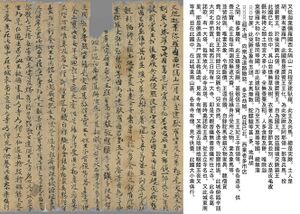
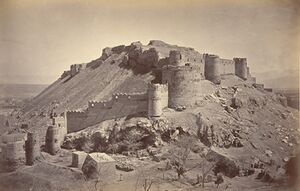
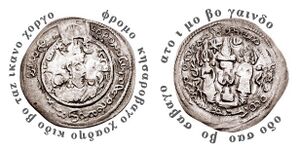

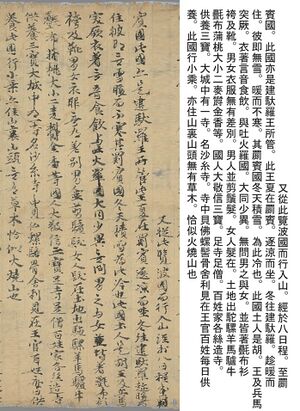
![Crowns with the head of a lion or a wolf[104] as central symbol, on the obverses of two Turk Shahi coins. This new symbol replaced the earlier bull's head of Nezak Huns coinage.[103]](/w/images/thumb/8/80/Turk_Shahi_lion_headdress.jpg/250px-Turk_Shahi_lion_headdress.jpg)
![Sasanian-style trilingual coin of Tegin Shah towards the end of his reign. Iranian god Adur on the reverse. Obverse legend: "His Excellence, the Iltäbär of Khalaj, Worshipper of the highest God, His Excellence, the King, the divine Tegin […]".[106] Date in Pahlavi: 728 AD](/w/images/thumb/6/61/Shahi_Tegin_728_CE.jpg/250px-Shahi_Tegin_728_CE.jpg)
![A Turk Shahis ruler named Sandan, otherwise unknown. Copy of a late issue of Khusrau II, combining Brahmi script around the ruler, Bactrian script along the two rims, where "ςανδανο βαγο χοαδηο" "Lord King Sandan" is mentioned, and Pahlavi around the altar on the reverse.[107][108]](/w/images/thumb/9/94/Turk_Shahis._Sandan._After_688_CE.jpg/250px-Turk_Shahis._Sandan._After_688_CE.jpg)



![Seated Buddha, Fondukistan monastery. National Museum of Afghanistan.[115]](/w/images/thumb/d/d3/Fondukistan_Seated_Buddha.jpg/137px-Fondukistan_Seated_Buddha.jpg)
![Seated Maitreya, 7th-8th century AD, near Kabul, Afghanistan. "Stylistically related to Shahi sculpture of northern Pakistan and Afghanistan".[116]](/w/images/thumb/b/b8/Seated_Maitreya%2C_7th-8th_century%2C_Kabul%2C_Afghanistan.jpg/130px-Seated_Maitreya%2C_7th-8th_century%2C_Kabul%2C_Afghanistan.jpg)
![Seated Avalokiteshvara, white marble, Khair Khaneh, 6th-7th century CE. Musée Guimet MA 8151.[127]](/w/images/thumb/0/0c/Seated_Avalokiteshvara%2C_white_marble%2C_Khair_Khaneh%2C_6th-7th_century_CE._Mus%C3%A9e_Guimet_MA_8151.jpg/136px-Seated_Avalokiteshvara%2C_white_marble%2C_Khair_Khaneh%2C_6th-7th_century_CE._Mus%C3%A9e_Guimet_MA_8151.jpg)
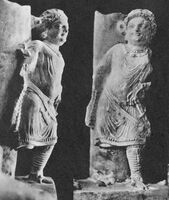
![The Gardez Ganesha is now dated to the 8th century and attributed to the Turk Shahis.[121]](/w/images/thumb/e/e1/Ganesha_from_Gardez.jpg/97px-Ganesha_from_Gardez.jpg)
